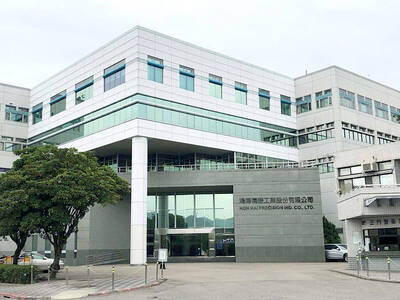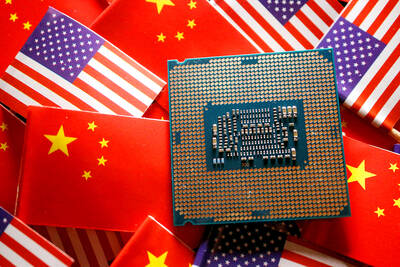Taishin Financial Holding Co (台新金控) expects loan growth to continue this quarter, but at a slower pace than last quarter as ongoing global economic uncertainty merits caution, senior executives told an investors’ conference yesterday.
The conglomerate offered its conservative guidance for the fourth quarter after net profits grew 5.7 percent during the July-to-September period to NT$4.93 billion (US$168.3 million), thanks to stronger sales of wealth management products, better investment returns, more efficient trading and increased exposure to China, Taishin Financial chief financial officer Welch Lin (林維俊) said.
Cumulative income for the first nine months rose to a three-year high of NT$8.6 billion, or earnings of NT$1.1 per share, an increase of 15.1 percent from the same period last year, Lin said.
“Looking forward, secured and unsecured lending operations are likely to stay flat in the current quarter from the third quarter, and so is corporate lending,” Lin said.
Loans to small and medium-sized enterprises may expand sequentially by 5 percent and underwriting operations by 15 percent, while wealth management may decline 5 percent in the fourth quarter because of a high base, Lin added.
Wealth management business, including insurance brokerage, generated NT$1.31 billion in net fee income last quarter, up 9.4 percent from the second quarter, the group’s financial report showed.
Bancassurance accounted for 70 percent, while mutual funds made up the remaining 30 percent, Taishin retail banking executive Oliver Shang (尚瑞強) said.
Sales of insurance policies through Taishin International Bank (台新銀行) peaked in June and July as clients rushed to buy various insurance policies before expense hikes, Shang said.
Taishin Bank, the group’s main source of income, reported NT$2.55 billion in net profits last quarter, a rise of 14 percent from three months earlier, as net interest income grew by 4 percent to NT$3.53 billion, while fee income picked up 6.4 percent to NT$1.96 billion, the report said.
Meanwhile, income from investment and trading operations surged 78.6 percent sequentially to NT$585 million, as the bank made gains on its financial assets, Lin said.
Net interest margin held steady at 1.44 percent at the end of September from June, while the overall interest spread narrowed from 2.04 percent to 2.01 percent, the report showed.
However, foreign currency exchanges saw the spread widen to 1.53 percent in the third quarter from 1.32 percent in the second quarter, the report said.
Taishin Bank plans to set aside an extra NT$300 million in provision by the end of the year to raise its bad loan reserve ratio from 0.97 percent to 1 percent of Tier 1 loans, Lin said.
Meanwhile, Taishin Financial, which inked a deal in August to buy the local unit of New York Life Insurance Co for NT$100 million, aims to file formal acquisition applications with authorities by the end of the month, Taihsin Financial president Joseph Jao (饒世湛) said.
The acquisition may not be a burden the conglomerate’s finances given the limited expense involved, Jao said.
Taishin Financial shares edged up 0.96 percent to NT$10.55 yesterday, outpacing the TAIEX’s 0.71 percent growth, Taiwan Stock Exchange data showed.

Nvidia Corp chief executive officer Jensen Huang (黃仁勳) on Monday introduced the company’s latest supercomputer platform, featuring six new chips made by Taiwan Semiconductor Manufacturing Co (TSMC, 台積電), saying that it is now “in full production.” “If Vera Rubin is going to be in time for this year, it must be in production by now, and so, today I can tell you that Vera Rubin is in full production,” Huang said during his keynote speech at CES in Las Vegas. The rollout of six concurrent chips for Vera Rubin — the company’s next-generation artificial intelligence (AI) computing platform — marks a strategic

Shares in Taiwan closed at a new high yesterday, the first trading day of the new year, as contract chipmaker Taiwan Semiconductor Manufacturing Co (TSMC, 台積電) continued to break records amid an artificial intelligence (AI) boom, dealers said. The TAIEX closed up 386.21 points, or 1.33 percent, at 29,349.81, with turnover totaling NT$648.844 billion (US$20.65 billion). “Judging from a stronger Taiwan dollar against the US dollar, I think foreign institutional investors returned from the holidays and brought funds into the local market,” Concord Securities Co (康和證券) analyst Kerry Huang (黃志祺) said. “Foreign investors just rebuilt their positions with TSMC as their top target,

REVENUE PERFORMANCE: Cloud and network products, and electronic components saw strong increases, while smart consumer electronics and computing products fell Hon Hai Precision Industry Co (鴻海精密) yesterday posted 26.51 percent quarterly growth in revenue for last quarter to NT$2.6 trillion (US$82.44 billion), the strongest on record for the period and above expectations, but the company forecast a slight revenue dip this quarter due to seasonal factors. On an annual basis, revenue last quarter grew 22.07 percent, the company said. Analysts on average estimated about NT$2.4 trillion increase. Hon Hai, which assembles servers for Nvidia Corp and iPhones for Apple Inc, is expanding its capacity in the US, adding artificial intelligence (AI) server production in Wisconsin and Texas, where it operates established campuses. This

US President Donald Trump on Friday blocked US photonics firm HieFo Corp’s US$3 million acquisition of assets in New Jersey-based aerospace and defense specialist Emcore Corp, citing national security and China-related concerns. In an order released by the White House, Trump said HieFo was “controlled by a citizen of the People’s Republic of China” and that its 2024 acquisition of Emcore’s businesses led the US president to believe that it might “take action that threatens to impair the national security of the United States.” The order did not name the person or detail Trump’s concerns. “The Transaction is hereby prohibited,”